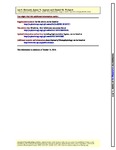Context-Dependent Partitioning of Motor Learning in Bimanual Movements
| dc.contributor.author | Howard, IS | |
| dc.contributor.author | Ingram, JN | |
| dc.contributor.author | Wolpert, DM | |
| dc.date.accessioned | 2019-10-22T12:38:15Z | |
| dc.date.available | 2019-10-22T12:38:15Z | |
| dc.date.issued | 2010-10 | |
| dc.identifier.issn | 0022-3077 | |
| dc.identifier.issn | 1522-1598 | |
| dc.identifier.uri | http://hdl.handle.net/10026.1/15027 | |
| dc.description.abstract |
<jats:p> Human subjects easily adapt to single dynamic or visuomotor perturbations. In contrast, when two opposing dynamic or visuomotor perturbations are presented sequentially, interference is often observed. We examined the effect of bimanual movement context on interference between opposing perturbations using pairs of contexts, in which the relative direction of movement between the two arms was different across the pair. When each perturbation direction was associated with a different bimanual context, such as movement of the arms in the same direction versus movement in the opposite direction, interference was dramatically reduced. This occurred over a short period of training and was seen for both dynamic and visuomotor perturbations, suggesting a partitioning of motor learning for the different bimanual contexts. Further support for this was found in a series of transfer experiments. Having learned a single dynamic or visuomotor perturbation in one bimanual context, subjects showed incomplete transfer of this learning when the context changed, even though the perturbation remained the same. In addition, we examined a bimanual context in which one arm was moved passively and show that the reduction in interference requires active movement. The sensory consequences of movement are thus insufficient to allow opposing perturbations to be co-represented. Our results suggest different bimanual movement contexts engage at least partially separate representations of dynamics and kinematics in the motor system. </jats:p> | |
| dc.format.extent | 2082-2091 | |
| dc.format.medium | Print-Electronic | |
| dc.language | en | |
| dc.language.iso | eng | |
| dc.publisher | American Physiological Society | |
| dc.subject | Adaptation, Physiological | |
| dc.subject | Arm | |
| dc.subject | Functional Laterality | |
| dc.subject | Humans | |
| dc.subject | Learning | |
| dc.subject | Motor Skills | |
| dc.subject | Movement | |
| dc.subject | Photic Stimulation | |
| dc.subject | Psychomotor Performance | |
| dc.title | Context-Dependent Partitioning of Motor Learning in Bimanual Movements | |
| dc.type | journal-article | |
| dc.type | Article | |
| plymouth.author-url | https://www.ncbi.nlm.nih.gov/pubmed/20685927 | |
| plymouth.issue | 4 | |
| plymouth.volume | 104 | |
| plymouth.publication-status | Published | |
| plymouth.journal | Journal of Neurophysiology | |
| dc.identifier.doi | 10.1152/jn.00299.2010 | |
| plymouth.organisational-group | /Plymouth | |
| plymouth.organisational-group | /Plymouth/Faculty of Science and Engineering | |
| plymouth.organisational-group | /Plymouth/Faculty of Science and Engineering/School of Engineering, Computing and Mathematics | |
| plymouth.organisational-group | /Plymouth/REF 2021 Researchers by UoA | |
| plymouth.organisational-group | /Plymouth/REF 2021 Researchers by UoA/UoA11 Computer Science and Informatics | |
| plymouth.organisational-group | /Plymouth/Users by role | |
| plymouth.organisational-group | /Plymouth/Users by role/Academics | |
| dc.publisher.place | United States | |
| dc.identifier.eissn | 1522-1598 | |
| dc.rights.embargoperiod | Not known | |
| rioxxterms.versionofrecord | 10.1152/jn.00299.2010 | |
| rioxxterms.licenseref.uri | http://www.rioxx.net/licenses/all-rights-reserved | |
| rioxxterms.type | Journal Article/Review |


